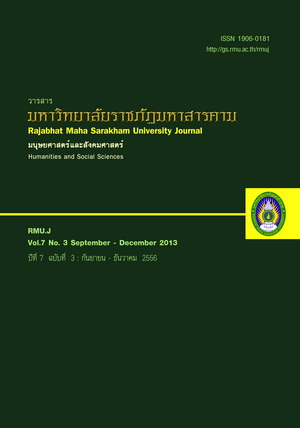การพัฒนารูปแบบการประเมินจิตวิทยาศาสตร์สำหรับนักเรียนชั้นมัธยมศึกษาปีที่ 1
Main Article Content
บทคัดย่อ
บทคัดย่อ
การวิจัยครั้งนี้มีวัตถุประสงค์ ประการแรก เพื่อพัฒนารูปแบบการประเมินจิตวิทยาศาสตร์สำหรับนักเรียนชั้นมัธยมศึกษาปีที่ 1 และ ประการที่สอง ศึกษาคุณภาพของรูปแบบการประเมินจิตวิทยาศาสตร์สำหรับนักเรียนชั้นมัธยมศึกษาปีที่ 1 กลุ่มผู้ให้ข้อมูลในการ พัฒนารูปแบบการประเมินจิตวิทยาศาสตร์สำหรับนักเรียนชั้นมัธยมศึกษาปีที่ 1 ได้แก่ ศึกษานิเทศก์และครูที่เชี่ยวชาญด้านการสอน วิทยาศาสตร์ จำนวน 9 คน กลุ่มผู้ให้ข้อมูลในการหาคุณภาพของรูปแบบการประเมินด้านความเหมาะสมและความเป็นไปได้ ได้แก่ อาจารย์ในมหาวิทยาลัย ศึกษานิเทศก์ และครูวิทยฐานะชำนาญการพิเศษ จำนวน 5 คน ผู้ให้ข้อมูลในการประเมินรูปแบบด้านความถูก ต้องครอบคลุมและความเป็นประโยชน์ ได้แก่ครูผู้สอนกลุ่มสาระการเรียนรู้วิทยาศาสตร์ชั้นมัธยมศึกษาปีที่ 1 จากโรงเรียนมัธยมและ โรงเรียนขยายโอกาสทางการศึกษา สังกัดสำนักงานเขตพื้นที่การศึกษากาฬสินธุ์ เขต 2 จำนวน 25 คน เครื่องมือที่ใช้ในการวิจัย คือ การ สนทนากลุ่ม (Focus group discussion) แบบสังเกตพฤติกรรมคุณลักษณะจิตวิทยาศาสตร์ แบบวัดจิตวิทยาศาสตร์เชิงสถานการณ์ แบบประเมินจิตวิทยาศาสตร์ด้วยตนเอง แบบสอบถามความคิดเห็นที่มีต่อรูปแบบการประเมินในด้านความเหมาะสม ความเป็นไปได้ ความถูกต้องครอบคลุมและความเป็นประโยชน์ สถิติที่ใช้ในการวิเคราะห์และแปลผลคือ ค่าร้อยละ ค่าเฉลี่ย ส่วนเบี่ยงเบนมาตรฐาน และการวิเคราะห์ค่าดัชนีความสอดคล้อง IOC ผลการวิจัยพบว่า
รูปแบบการประเมินจิตวิทยาศาสตร์สำหรับนักเรียน ชั้นมัธยมศึกษาปีที่ 1 มีองค์ประกอบ จำนวน 4 ด้าน ได้แก่ ด้านวัตถุประสงค์ ของรูปแบบการประเมิน ด้านเครื่องมือการประเมิน ด้านวิธีการประเมิน และด้านเกณฑ์การประเมิน ผลการประเมินคุณภาพโดยผู้ เชี่ยวชาญพบว่า ก่อนนำไปทดลองใช้รูปแบบการประเมินมีความเหมาะสมอยู่ในระดับมาก และมีความเป็นไปได้อยู่ในระดับมาก หลัง จากนำรูปแบบการประเมินไปใช้พบว่า มีความถูกต้องครอบคลุมอยู่ในระดับมาก และด้านความเป็นประโยชน์อยู่ในระดับมาก สรุปได้ ว่ารูปแบบการประเมินจิตวิทยาศาสตร์สำหรับนักเรียนชั้นมัธยมศึกษาปีที่ 1 มีคุณภาพและสามารถนำไปใช้ได้จริง และเป็นต้นแบบนำ ไปปรับปรุงใช้กับนักเรียนในระดับชั้นอื่น ๆ ได้
คำสำคัญ : จิตวิทยาศาสตร์
ABSTRACT
This research aimed to develop an assessment model for scientific mind of grade 7th students and assess the qualities of the evaluation model. The participants in developing the assessment model were nine education supervisors and Science teachers. Whereas, the participants in assessing the appropriateness and possibility of the model were five university lecturers, education supervisors and Science teachers. The participants in assessing the accuracy, coverage and benefits of the model were 25 Science teachers from secondary schools and extended secondary schools under Kalasin Educational Service Area Office 2. The research instruments were an observation from, a scientific test, a self-assessment from, and a questionnaire. The focus group discussion method was employed for the research, The statistics used for data analysis were percentage, mean, standard deviation, and index of item-objective congruence.
The research result showed that the assessment model for scientific mind of grade 7th students consisted of four parts; objectives, instruments, methods, and criteria. The results indicated that the average level of the appropriateness and possibility of the model assessed by the experts was high before using the model to the target group. After using the model to the target group, the finding showed that the average level of the accuracy, coverage and benefits of the model was high. In conclusion, the evaluation model for Scientific mind of 7th grade students is efficient and practical for the instruction, and the model is able to be adopted to other level.
Keyword : Assessment Model Scientific Mind
Article Details
1. บทความที่ลงตีพิมพ์ทุกเรื่องได้รับการตรวจทางวิชาการโดยผู้ประเมินอิสระ ผู้ทรงคุณวุฒิ (Peer Review) สาขาที่เกี่ยวข้อง อย่างน้อย 3 ท่าน ในรูปแบบ Double blind review
2. ข้อคิดเห็นใด ๆ ของบทความที่ลงตีพิมพ์ในวารสารมหาวิทยาลัยราชภัฏมหาสารคาม นี้เป็นของผู้เขียน คณะผู้จัดทำวารสารไม่จำเป็นต้องเห็นด้วย
3. กองบรรณาธิการวารสารมหาวิทยาลัยราชภัฏมหาสารคาม ไม่สงวนสิทธิ์การคัดลอกแต่ให้อ้างอิงแสดงที่มา


